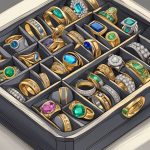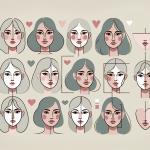Types Of Diamonds
Diamonds are one of the most sought-after precious stones in the world. They are valued for their beauty, durability, and rarity. Diamonds come in many different types, each with its own unique characteristics. Understanding the different types of diamonds can help you make an informed decision when purchasing a diamond.
The Gemological Institute of America (GIA) is the leading authority on diamond grading and identification. They classify diamonds based on the presence or absence of certain elements and impurities. The most common types of diamonds are Type Ia, Type Ib, Type IIa, Type IIb, and Type III. Type Ia diamonds are the most common and make up about 98% of all natural diamonds. Type II diamonds are much rarer and have different physical and chemical properties than Type I diamonds.
When evaluating diamond quality, the 4Cs are used: carat weight, color, clarity, and cut. Carat weight refers to the size of the diamond, while color refers to the presence or absence of color in the diamond. Clarity refers to the number and size of inclusions or blemishes in the diamond, and cut refers to the angles and proportions of the diamond. Understanding these factors can help you choose a diamond that meets your needs and budget.
Key Takeaways
- There are different types of diamonds, including Type Ia, Type Ib, Type IIa, Type IIb, and Type III.
- The 4Cs (carat weight, color, clarity, and cut) are used to evaluate diamond quality.
- Understanding the different types of diamonds and the 4Cs can help you make an informed decision when purchasing a diamond.
Classification by Type

Diamonds are classified into two main types based on the presence or absence of nitrogen and boron impurities in their atomic structure. The type classification system is a scientific method of categorizing diamonds according to their chemical composition, which affects their physical and optical properties.
Type I Diamonds
Type I diamonds contain nitrogen impurities, which account for the majority of natural diamonds. They are further classified into two subtypes: Type Ia and Type Ib. Type Ia diamonds are the most common and contain nitrogen atoms in isolated form. They can be further subdivided into Type IaA and Type IaB based on the presence of additional nitrogen atoms. Type Ib diamonds, on the other hand, contain nitrogen atoms in aggregated form and are less common than Type Ia diamonds.
Type II Diamonds
Type II diamonds are rare and contain little to no nitrogen impurities. Instead, they contain boron impurities, which give them a blue or gray coloration. Type II diamonds are further classified into two subtypes: Type IIa and Type IIb. Type IIa diamonds are the purest form of diamond and contain no impurities other than carbon. They are known for their exceptional optical properties and are often colorless or near-colorless. Type IIb diamonds, on the other hand, contain trace amounts of nitrogen and boron impurities, which give them a bluish-gray coloration.
In summary, the type classification system of diamonds is an important tool for gemologists and diamond experts to determine a diamond’s chemical composition and physical properties. By understanding the different types of diamonds, one can better evaluate their value, rarity, and authenticity.
Evaluating Diamond Quality
When evaluating the quality of a diamond, there are several factors to consider. These factors include the 4Cs of diamonds, which are cut, color, clarity, and carat weight. In addition to these factors, the shape of the diamond, its symmetry, and its fluorescence can also affect its overall quality.
The 4Cs of Diamonds
The 4Cs of diamonds are the widely accepted standard characteristics for a diamond that determine its quality and value. The cut of a diamond is the most important factor in determining its brilliance and sparkle. A well-cut diamond will reflect light in a way that maximizes its fire and brilliance.
The color of a diamond is also an important factor in its quality. Diamonds are graded on a scale from D (colorless) to Z (light yellow or brown). The less color a diamond has, the more valuable it is.
The clarity of a diamond refers to the presence of inclusions or blemishes within the stone. The fewer inclusions a diamond has, the more valuable it is. The clarity of a diamond is graded on a scale from Flawless (no inclusions or blemishes visible under 10x magnification) to Included (inclusions visible to the naked eye).
Carat weight is the final factor in the 4Cs of diamonds. Carat weight refers to the weight of the diamond, with one carat equaling 0.2 grams. The larger the diamond, the more valuable it is.
Diamond Cut and Shapes
Diamonds can be cut into a variety of shapes, including round, princess, emerald, and pear. The shape of a diamond can affect its overall quality and value. For example, a well-cut round diamond will have more fire and brilliance than a poorly cut princess diamond.
Symmetry is also an important factor in the cut of a diamond. A well-cut diamond will have symmetrical facets that reflect light evenly. If a diamond is cut with poor symmetry, it can affect its overall sparkle and brilliance.
Color and Clarity
In addition to the 4Cs of diamonds, the color and clarity of a diamond can also affect its overall quality. Diamonds with a D color grade are the most valuable, as they are completely colorless. Diamonds with a lower color grade can have a yellow or brown tint, which can affect their value.
The clarity of a diamond is also an important factor in its quality. Inclusions and blemishes can affect the overall appearance of a diamond, and can also affect its value. A diamond with no visible inclusions or blemishes is considered to be of higher quality and value than one with visible inclusions.
In conclusion, when evaluating the quality of a diamond, it is important to consider a variety of factors, including the 4Cs of diamonds, the shape of the diamond, its symmetry, and its fluorescence. By understanding these factors, you can make an informed decision when purchasing a diamond.
Fancy Colored Diamonds
Fancy-colored diamonds are a beautiful and rare type of diamond that come in a variety of colors. These diamonds are highly sought after and can be quite valuable. In this section, we will discuss natural colored diamonds, as well as treated and lab-grown colored diamonds.
Natural Colored Diamonds
Natural colored diamonds are diamonds that have been formed naturally with color. These diamonds are extremely rare and can be very expensive. Some of the most well-known natural colored diamonds include the red diamond, blue diamond, yellow diamond, pink diamond, and green diamond.
The red diamond is the rarest of all colored diamonds, with only a few known to exist. Blue diamonds are also very rare and can be quite valuable. Yellow diamonds are more common than red or blue diamonds, but still very rare. Pink diamonds are also highly sought after and can be quite expensive. Green diamonds are the rarest of all colored diamonds, with only a few known to exist.
Treated and Lab-Grown Colored Diamonds
Treated and lab-grown colored diamonds are a more affordable option for those who want a colored diamond. Treated diamonds are natural diamonds that have been treated to enhance their color. Lab-grown diamonds are created in a laboratory and can be made in a variety of colors.
Treated diamonds can be a good option for those who want a natural diamond with enhanced color. However, it is important to note that treated diamonds are not as valuable as natural colored diamonds. Lab-grown diamonds are a more affordable option that can be made in a variety of colors, including pink, blue, and yellow.
Overall, fancy-colored diamonds are a beautiful and rare type of diamond that come in a variety of colors. Natural colored diamonds are extremely rare and can be very expensive, while treated and lab-grown colored diamonds are more affordable options.
Diamond Shapes and Cuts
Diamonds come in a variety of shapes and cuts, each with its own unique characteristics. Understanding the different types of diamond shapes and cuts can help you choose the perfect diamond for your needs. In this section, we will explore the most popular diamond shapes and cuts, including round, princess cut, emerald cut, cushion cut, oval, marquise, heart, pear, asscher cut, radiant, and emerald.
Round and Princess Cut
The round cut diamond is the most popular diamond shape and is known for its brilliant sparkle. It is also the most versatile shape, as it can be used in a variety of settings. The princess cut diamond is the second most popular diamond shape and is known for its sharp corners and brilliance. It is a great option for those who want a modern look.
Fancy Shapes
Fancy shaped diamonds include cushion, emerald, oval, marquise, heart, and pear. The cushion cut diamond is a square or rectangular shape with rounded corners, giving it a softer, more romantic look. The emerald cut diamond is a rectangular shape with cut corners, giving it a more vintage look. The oval diamond is an elongated shape that can make fingers appear longer and slimmer. The marquise diamond is a football-shaped diamond with pointed ends, giving it a unique look. The heart-shaped diamond is a romantic choice, perfect for engagement rings. The pear-shaped diamond is a teardrop-shaped diamond that is elegant and timeless.
When choosing a diamond shape and cut, it is important to consider your personal style and preferences. Each shape and cut has its own unique characteristics, so take the time to explore your options and find the perfect diamond for you.
Diamonds in Jewelry
Diamonds have long been a popular choice for jewelry, especially engagement rings. According to a survey conducted by The Knot in 2021, 85% of all engagement rings include a clear diamond, making it the most popular choice for such rings.
When it comes to jewelry, diamonds are often chosen for their unique beauty and ability to symbolize love and commitment. They can be found in a variety of shapes, sizes, and colors, making them a versatile choice for any type of jewelry.
For those looking for a unique piece of diamond jewelry, there are many options available. From colored diamonds to unusual cuts, there are endless possibilities for creating a one-of-a-kind piece. However, it is important to keep in mind that these unique options may come at a higher cost.
When purchasing diamond jewelry, it is important to have a guide to help navigate the process. This can include information on the 4 Cs of diamonds (cut, color, clarity, and carat weight), as well as information on the different types of diamonds available.
Overall, diamonds are a timeless choice for jewelry, particularly when it comes to engagement rings. Their beauty and symbolism make them a popular choice for those looking to express their love and commitment.






